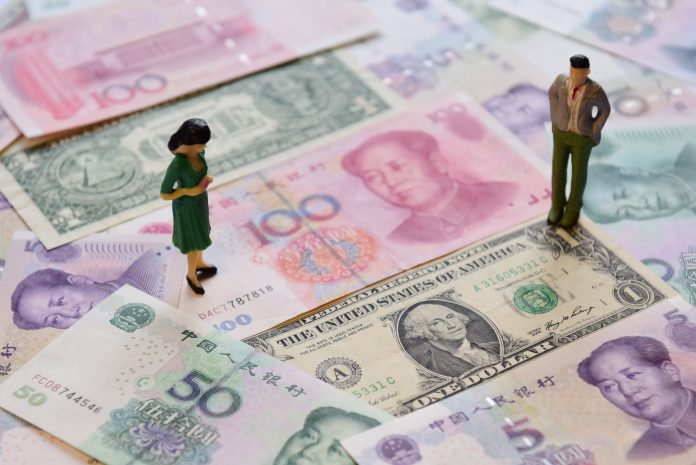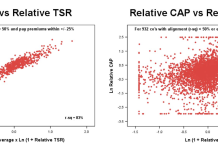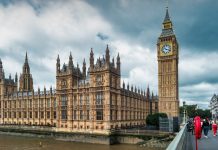Gidon Gautel, China Foresight Project Coordinator at LSE IDEAS, discusses how COVID-19 could impact US-China trade relations as the economy attempts to recover
For two and a half years, the world has been subject to the spectacle of the US-China trade war. The two countries reached a temporary truce in January 2020 under the phase one trade deal, which saw the US cease tariff escalation and China commit to increasing intellectual property protection and $200 billion in goods and services purchases from the US. However, COVID-19 is severely impacting China’s ability to execute on its promised purchases, which were already deemed unrealistic. This, alongside flaring tensions, is throwing the US-China trade relationship back into the limelight.
COVID-19: The immediate economic impact
COVID-19 has sparked a war of words and fears of a return to escalating tariffs on both sides. However, the collapse of the phase one trade deal does not seem imminent, at least for now. While President Trump has repeatedly indicated his change of heart regarding the deal, others in his administration have touted a more cautious line. Larry Kudlow, Director of the National Economic Council, rejected suggestions the deal is falling apart a mere day after Trump expressed his misgivings. Representatives from the US and China pledged their continued commitment to the deal on May 8th. With the US presidential elections looming in November, it is not in Trump’s interest to scupper the agreement and revert to a hiking of tariffs on Chinese goods. One of the few wins of his administration, ditching the deal would leave him with less campaign material. If Trump re-escalated trade tensions, this would deepen the global recession, and likely punish his own voters.
If Trump re-escalated trade tensions, this would deepen the global recession, and likely punish his own voters.
Nevertheless, phase one deal’s implementation will be severely impacted by the economic disruption triggered by COVID-19. The Centre for Strategic & International Studies reported in early May that it now sees China reaching the targets of the phase one deal as “impossible.” Chinese tariffs remain on US goods, depressing domestic demand for imports from America. While these tariffs are steadily being reduced, they are still higher than those on other international suppliers. If China’s private sector was unlikely to ramp up purchases of US goods before the crisis, a global economic downturn leaves this possibility in the realms of fantasy. China’s central government could intensify pressure on state-owned enterprises to reach the targets; however, this comes with a litany of its own problems. Besides, if the amount of US goods available for export is reduced due to COVID-related disruption—for example, due to meatpacking plant closures—this becomes a moot point. China cannot buy what the US is not producing.
Within Trump’s vision, the future of US-China trade is largely dependent on the fulfilment of the phase one deal and on-going negotiations around phase two, which will deal with thornier issues such as data flows and the role of state-owned enterprises in the Chinese economy. These talks have now stalled; even if they do pick up the pace again, little headway will be made before November. Many people thought it highly unlikely that a phase two deal would be struck before the November election even before COVID-19 hit the West. Since the pandemic, the likelihood of this happening is now fanciful. For now, therefore, trade will suffer at the hands of the virus, as it has around the world. Beyond the November election, the extent of COVID-19’s impact on trade might be determined by more fundamental political shifts on the US side.
The view from China
China benefits considerably from an open global trading system and has little interest in a sustained drop in trade with the US. China’s Premier, Li Keqiang, reiterated that China would implement the phase one deal during China’s two sessions on May 22nd, the country’s annual meeting of senior lawmakers.
In the same report, he encouraged a broad program of opening up China’s markets further to foreign trade and investment, expanding free trade zones, and maintaining and “reforming” the global multilateral trading system.
For now, therefore, China will continue to strive to implement the phase one deal. Under the deal, China and the US can initiate consultations in the case of “unforeseen circumstances,” for which one could argue COVID-19 certainly qualifies. The Chinese government could, therefore, seek to initiate consultations after the US election with whichever administration it produces. Whether the US plays ball is dependent on who is elected president and how badly damaged US-China relations are by the end of the year. Should the phase one deal survive, China will likely seek to delay for as long as possible the difficult conversations around phase two.
Beijing will try to counter de-globalisation and global technological decoupling by aggressively promoting Chinese technological standards
In the longer term, Beijing will try to counter de-globalisation and global technological decoupling by aggressively promoting Chinese technological standards and pushing its trade interests through domestic policies and through bodies such as the WTO. As was the case with the trade war, Beijing’s approach to the US will probably continue to be reactive. Zhou Xiaoming, Former Deputy Permanent Representative of China’s Mission to the UN, argued in February that Beijing was emboldened by the surprising resilience of the Chinese economy in the face of US tariffs. This in mind, the importance of the US trade relationship may in fact wane for Beijing, if it can be compensated for by improved trade relations with less volatile partners.
In a sense, the Chinese position on trade with the US is therefore comparatively stable. It is certainly far more predictable than that of the US. The long-term impact COVID-19 has on US-China trade relations is therefore largely dependent on the impact it has on US domestic politics.
The long-term: US domestic politics
US-China trade is currently being shaped by economic forces as COVID-19 squeezes suppliers and leaves demand weakened. However, the fate of the two countries’ trade relationship beyond the November election is overwhelmingly dependent on political forces. As in most other areas, Donald Trump and Joe Biden’s approaches to trade are fundamentally antithetical. Whoever is sworn in on 20 January 2021, therefore, will be decisive in shaping the US’s relationship with China for many years.
Should Trump win the election, a difficult conversation will have to be had about the terms of the phase one trade deal (if it does not collapse beforehand). Both parties will internalise that China will likely not fulfil its purchasing obligations by the 2021 deadline. What would happen next is largely dependent on the overall state of the US-China relationship after months of China-bashing in what is almost certain to be an ugly presidential campaign. If Trump is somehow able to rebuild some good faith between both sides, the two countries could renegotiate the terms of the deal and resume negotiations for phase two. Given Trump’s on-going fixation with the trade deficit, his administration may continue to kick the can of Chinese structural reform down the road, in exchange for further actions congruent with a reduction in the trade deficit. If not, and the agreement collapses, we may see a return to the trade volatility that has rocked markets for the past two years. Even if all goes perfectly, and China ramps up imports sufficiently to placate the Trump administration, US producers may face a cliff edge as artificially inflated purchases crash after December 31st 2021.
Meanwhile, if Biden wins, one should not expect an uptick in trade between the countries or any further deal-making; nor should one expect a return to the Obama-Biden years of US-China trade. While Biden has criticised Trump’s tariffs on China for hurting US farmers and consumers, he has not committed to removing them once in office. He has pledged to form a grand coalition of US allies to put pressure on China to initiate internal structural reforms. Additionally, writing on his approach to global trade in a Foreign Policy op-ed, Biden has said he will not enter into new trade agreements until sufficient domestic investment has left Americans equipped “to succeed in the global economy.” He has also made strong labour and environmental standards a precondition for any trade agreements.
This suggests Biden would be unlikely to sign trade deals that offer little in Chinese structural reform. His approach is worthwhile but would be difficult and time-consuming. President Trump has pushed relations with traditional allies to their limits. America’s allies were already lukewarm on following the US’s lead on China even before the Trump presidency. After four years of Trump, Biden would face a monumental task of rebuilding lost trust. This will take time. While Trump has shown his willingness to push fundamental issues aside for quick wins, Biden is unlikely to take such an approach.
After four years of Trump, Biden would face a monumental task of rebuilding lost trust
Both administrations would run into the same roadblocks in any future negotiations. For example, digital trade will remain a contentious issue as China is unlikely to change its stance on data sovereignty and cross-border data flows. The difference in administrations will lie in the relative volatility in trade relations. Major improvements in the trade relationship under Biden, being conditional on the resolution of fundamental issues, are unlikely. He would also, however, be unlikely to worsen the situation by introducing costly tariffs. Under Trump, US-China trade relations may see far more movement. We could see tariffs reintroduced and trade plummet. If Trump is willing to forego discussions on thornier issues to focus on the trade deficit, we may even continue to see upwards movement in Chinese imports, though this would be at the expense of US long-term interests. The question of how COVID-19 will impact US-China trade relations will, therefore, be answered most directly by the results of the November election.
Moving beyond trade
As many have noted, the dispute between the US and China was never solely about trade, but long-term strategic competition. Regardless if Trump or Biden wins in November, therefore, the front in economic conflict between the US and China is likely to broaden. Recent actions by the Trump administration already suggest a move towards non-tariff escalation. US-China frictions are therefore moving away from ‘simple’ shocks to goods and services trade and more towards de-coupling of entire supply chains and a capital war focused around financial markets.
If US-China relations do not improve, trade may just become one of many economic casualties. Recent controversies around Hong Kong are a metaphor for this phenomenon. Following the indication that China will seek to impose national security laws on Hong Kong, Mike Pompeo recently announced that the US could revoke its special trade relationship with Hong Kong, whereby the region is essentially treated as a separate trade entity to Mainland China. Were this to happen, the hit in trade to both the US and China would be comparatively modest. Fortune noted last year that the fraction of American goods exported to Hong Kong was just 2.3% of 2018’s total. However, this action would devastate the city’s status as China’s financial gateway, with grave consequences for capital flows. This demonstrates that if US-China relations continue to depreciate, damages to their trading relationship may be overshadowed by far greater economic and geopolitical upheaval.
Moving beyond US-China animosity, there are broader reasons related to the changing nature of globalisation why trade may take more of a backseat looking forward. The economist Dani Rodrik argued in early May for a globalisation characterised by health and climate rather than investment and trade. Were globalisation to shift in this way, the focus on trade may then give way to what Anne-Marie Slaughter, CEO of New America, described as globalisation of global and political problem-solving in a recent Chatham House roundtable. Therefore, in the wake of COVID-19, perhaps the best one can hope for the US and China will be a stable, reduced trading relationship, overshadowed by protracted negotiations, and limited cooperation on issues of mutual interest or global importance.











